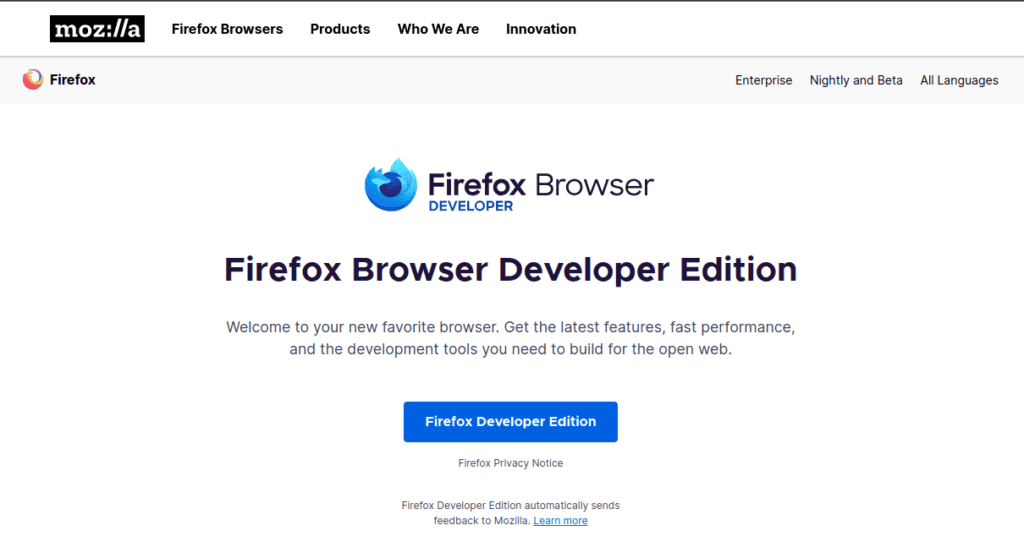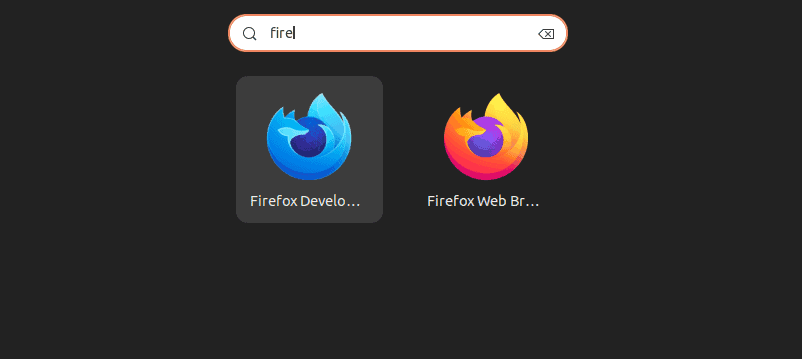1. Overview
Firefox Developer Edition is a special version of the Mozilla Firefox browser designed for web developers. It contains powerful features to help developers build and debug web applications.
In this tutorial, we go through the steps to set up this browser in Linux.
2. Downloading Firefox Developer Edition
Before we proceed, we need to ensure that we have administrative privileges to install the software. Also, we should establish a stable internet connection to download the Firefox Developer Edition package.
Now, let’s open our web browser of choice and navigate to the official Firefox Developer Edition download page:

While on this page, we’ll click the Firefox Developer Edition button to download the necessary tar file.
3. Extracting the tar Archive
Next, let’s open our terminal and navigate to the Downloads directory to extract the downloaded archive. In particular, we’ll work with the tar command to extract the files from the tarball:
$ sudo tar xjf firefox-121.0b7.tar.bz2
- tar – this command either extracts or creates an archive file
- xjf – the x option instructs tar to extract the contents of the firefox-121.0b7.tar.bz2 archive, j instructs tar to decompress the archive using the bzip2 compression, and f represents the filename of the archive file
After the extraction, we get the firefox directory. However, we’ll have to utilize the mv command and move this directory from the Downloads directory to a different location:
$ sudo mv firefox /opt/firefox-developer-edition
- mv – this command moves the firefox directory to the /opt directory
- /opt/firefox-developer-edition – represents the destination directory where firefox is moved to. mv creates the firefox-developer-edition directory if it doesn’t exist
Above, we move the extracted firefox directory to the /opt directory to make it accessible system-wide. To clarify, the /opt directory is a standard location for storing third-party applications in Linux.
4. Creating a Symbolic Link
In this section, we need to use the ln command to create a symbolic link. To explain, this link will allow us to launch Firefox Developer Edition from the terminal:
$ sudo ln -s /opt/firefox-developer-edition/firefox /usr/local/bin/firefox-developer-edition
- ln -s – this command creates links between files, and the -s option instructs ln to create a symbolic link
- /opt/firefox-developer-edition/firefox – represents the path to the executable file firefox found inside the extracted firefox-developer-edition directory
- /usr/local/bin/firefox-developer-edition – constitutes the path and the name of the symbolic link to be created
Now, launching Firefox Developer Edition is easy:
$ firefox-developer-edition
At this time, we’re able to open Firefox Developer Edition by simply typing firefox-developer-edition in the terminal.
5. Creating a Desktop Entry File
A desktop entry file is a file that determines how an application should appear in desktop menus and application launchers. Therefore, we’ll create a desktop entry file so that we’re able to launch Firefox Developer Edition from our desktop environment:
$ nano ~/.local/share/applications/firefox-developer-edition.desktop
Once the nano text editor opens the file, let’s paste:
[Desktop Entry]
Name=Firefox Developer Edition
Exec=/opt/firefox-developer-edition/firefox
Icon=/opt/firefox-developer-edition/browser/chrome/icons/default/default128.png
Type=Application
Categories=Network;WebBrowser;
- Name – defines the application display name
- Exec – specifies the command to execute when the application launches (the firefox executable)
- Icon – represents the path to the application icon file (default128.png)
- Type – states that the type of desktop entry is an application
- Categories – categorizes the application under Network and WebBrowser
Note that if the firefox-developer-edition.desktop file doesn’t exist, then nano creates it for us. This happens as soon as we press Ctrl + X, Y, and then Enter to save our changes. Equally important, we store this file in the ~/.local/share/applications directory since it’s where desktop entries for applications are stored.
Finally, let’s confirm that our desktop entry file works fine:

At this point, Firefox Developer Edition now appears in the Linux application menu.
6. Conclusion
In this article, we discussed how to easily install Firefox Developer Edition in Linux. Now, we can enjoy the many developer-friendly tools this browser provides to streamline our workflow.